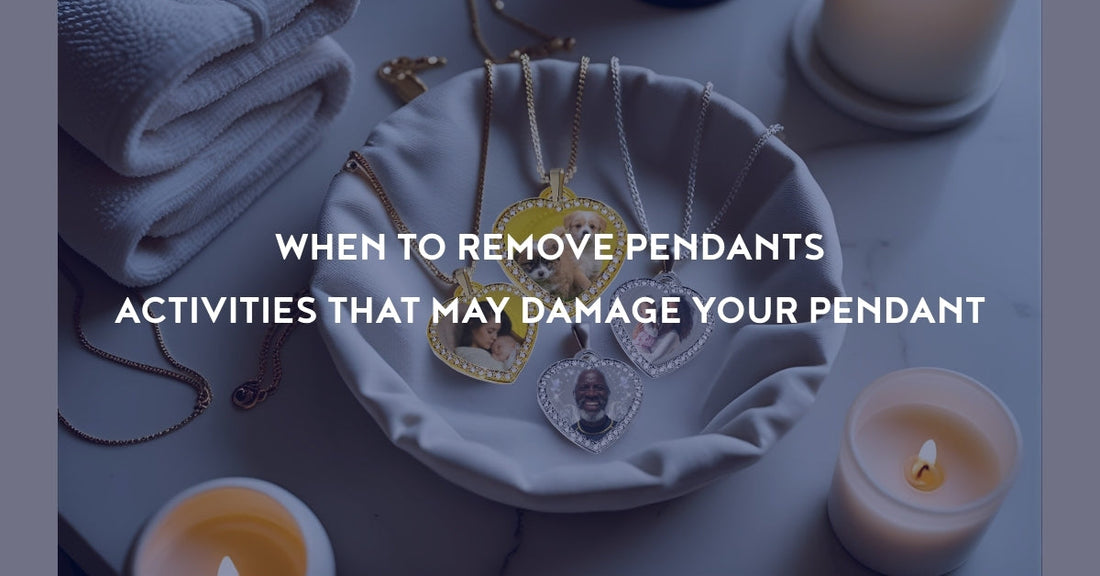
When to Remove Pendants : Activities That May Damage Your Pendant
Share
Pendant jewelry tells a story. Whether it’s a memorial pendant that holds a loved one’s photo, a necklace given as a gift, or a bracelet marking a milestone, your pieces carry both emotional and financial value. But while we love wearing them every day, not all moments are safe for jewelry.
Pendant Jewelry Is Meant to Be Worn, but Not Everywhere
Daily activities can scratch, tarnish, or even break your favorite keepsakes without you realizing it. A little mindfulness can go a long way in protecting your jewelry, so it continues to shine for years to come.
We’ll take a look at some everyday activities that can damage your pendants and other jewelry, along with simple tips to help keep them safe.

Why Jewelry Care Matters
Jewelry isn’t just metal and stone, it’s memory. Memorial jewelry especially carries irreplaceable emotional weight. A pendant containing a photo and optional with a loved one’s name cannot simply be replaced if damaged.
Beyond sentimental value, jewelry is also a financial investment. Gold and silver pieces can last a lifetime if properly cared for, while neglect can lead to fading, scratches, and costly repairs.
Think of your jewelry as you would a favorite piece of clothing: you wouldn’t wear silk to scrub floors, or suede shoes to the beach. With the right habits, you can keep your jewelry as beautiful and meaningful as the day you first wore it.

Activities That Can Harm Jewelry
💧 1. Swimming (Pools, Oceans, and Lakes)
Swimming may feel harmless, but it’s one of the biggest culprits in damaging jewelry:
-
Chlorine in pools weakens metals and can discolor gold and silver.
-
Saltwater corrodes plating and tarnishes silver quickly.
-
Sand acts like sandpaper, scratching pendants, chains, and crystal borders.
Even more concerning, water makes jewelry slippery, increasing the risk of losing a pendant to the bottom of a pool or the waves of the ocean.
Quick Tip: Always remove jewelry before diving into water. If you’re heading to the beach, leave precious pieces at home rather than risk damage or worse, losing them in the waves.

🏋️ 2. Exercising & Sports
Your pendant may feel light, but intense movement can put stress on chains and clasps.
-
Sweat causes tarnish and buildup on metals.
-
Physical impact can bend or crack delicate pendants.
-
Chains may snag on equipment or clothing.
Sports like basketball, running, or yoga may not seem risky, but even small tugs or pressure can wear down clasps over time.
Quick Tip: Keep a small pouch in your gym bag for storing jewelry while you work out.

🧽 3. Cleaning & Household Chores
Household cleaners are some of the most damaging substances for jewelry.
-
Bleach, ammonia, and harsh detergents strip away polish and weaken adhesives.
-
Scrubbing can scratch metal and stones.
-
Even dish soap leaves behind residue that dulls shine.
It’s also easy to accidentally hit your pendant against hard surfaces, leading to dents or chips.
Quick Tip: Before doing dishes or cleaning, take a moment to slip off your pendant and store it safely.

🛁 4. Showering & Bathing
Many people never remove jewelry in the shower, but here’s why you should:
-
Soap scum builds up, dulling shine over time.
-
Shampoo, conditioner, and lotions leave behind film.
-
Hot water weakens adhesives in crystal settings.
Even body washes with moisturizers can leave cloudy residue on jewelry, making pendants look duller with each wash.
Quick Tip: Create a “bathroom jewelry dish” to place items in before showering or bathing.

🌙 5. Sleeping with Jewelry On
While sleeping may seem harmless, it’s actually rough on jewelry:
-
Chains tangle and weaken.
-
Pendants can bend if you roll onto them.
-
Stones and crystals may loosen from constant pressure.
Over time, this nightly wear and tear weakens settings, making pendants more likely to break or lose details.
Quick Tip: Build a bedtime habit of removing jewelry along with makeup and skincare.

🖐️ 6. Applying Lotions, Perfumes, or Hair Products
The finishing touch to your morning routine could be harming your jewelry.
-
Perfume contains alcohol, which tarnishes silver.
-
Lotions and oils leave behind residue that dulls brilliance.
-
Hairspray and mousse coat pendants, making them lose sparkle.
Quick Tip: Follow the rule of thumb: put jewelry on last, take it off first.

🛠️ 7. DIY, Gardening, or Heavy Work
Working with your hands puts jewelry at the highest risk.
-
Tools and heavy lifting cause dents and scratches.
-
Dirt builds up textured 3D photo settings.
-
Chains can break easily outdoors, making pieces difficult to recover.
Quick Tip: If you’ll be working outside or with tools, it’s best to leave jewelry in a secure spot indoors.

How to Protect Your Jewelry
✅ Create a “Jewelry Off” Routine
The easiest way to protect your pieces is by building a habit. Before showering, swimming, or cleaning, pause and remove your jewelry. Keep a small tray or pouch in key areas — the bathroom, bedside table, or gym bag — so you always have a safe spot to place them.
✅ Store Pieces Properly
Storing jewelry correctly is just as important as when you wear it.
-
Use a soft-lined jewelry box or anti-tarnish pouch.
-
Keep pendants separate to prevent scratches.
-
Never leave jewelry in humid bathrooms.
✅ Clean Jewelry Safely
-
Use warm water, a drop of mild soap, and a soft cloth.
-
Dry completely before storing.
-
Avoid ultrasonic cleaners, especially for photo pendants or crystal borders, as they can loosen delicate settings.
✅ Extra Protection While Traveling
When traveling, jewelry is more at risk of loss or damage.
-
Use a travel jewelry case with compartments.
-
Avoid wearing valuable pendants at airports where they may set off scanners.
-
Carry jewelry in your personal bag rather than checked luggage.

Special Note: Caring for Memorial Jewelry
Memorial pendants deserve extra care. Unlike ordinary accessories, they hold deep emotional significance. Scratches or tarnish may feel like damage to the memory itself.
To preserve these keepsakes:
-
Wear them during meaningful moments, but store them during risky activities.
-
Consider having a “wearing piece” and a “keepsake piece” if your pendant is irreplaceable.
-
Clean gently and regularly, keeping the memory as fresh as the shine.

FAQs About Jewelry Care
Can I wear jewelry in the rain?
Light rain usually won’t harm gold or silver, but it’s best to remove jewelry in heavy rain to avoid water exposure and risk of loss.
What if I forget to take my pendant off?
Don’t panic — one accidental shower or workout won’t ruin it. Just clean and dry it immediately afterward.
Is it safe to wear jewelry every day?
Yes, if you follow safe practices and remove it during risky activities. Many people wear pendants daily for decades without damage by following these tips.
Do I need insurance for my jewelry?
For valuable or irreplaceable memorial jewelry, insuring it provides peace of mind. It won’t replace the sentiment, but it can help cover repairs or replacements.
Wear it Dont Wear it Out
Your jewelry is meant to be worn and enjoyed, but not everywhere. By being mindful about when to remove your pendants, you can keep them shining for years to come.
Protecting your jewelry is more than just care; it’s preserving the love, memory, and story each piece represents.

